Fibrous root system - Study guides, Class notes & Summaries
Looking for the best study guides, study notes and summaries about Fibrous root system? On this page you'll find 735 study documents about Fibrous root system.
Page 4 out of 735 results
Sort by
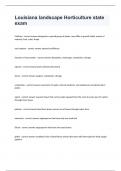
-
Louisiana landscape Horticulture state exam questions and complete correct answers 2024
- Exam (elaborations) • 12 pages • 2024
-
- $14.99
- + learn more
Cultivars - correct answer designates a special group of plants, may differ in growth habit, season of maturity, fruit, color, shape root systems - correct answer taproot and fibrous function of root system - correct answer absorption, anchorage, conduction, storage taproot - correct answer grows directly downward stems - correct answer support, conduction, storage conduction - correct answer movement of water, mineral solutions, and substances manufactured in plants xylem - co...
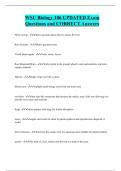
-
WSU Biology 106 UPDATED Exam Questions and CORRECT Answers
- Exam (elaborations) • 8 pages • 2024
-
- $7.99
- + learn more
Shoot system - above-ground organs (leaves, stems, flowers) Root Systems - Below ground (roots) 3 basic plant organs - roots, stems, leaves Root Responsibilities - Anchor plant to the ground, absorb water and nutrients, and store organic nutrients Taproot - Single, large root like a carrot. fibrous root - multiple small stringy roots from one main stem root hairs - tiny hair-like extensions that increase the surface area of the root allowing it to absorbs more water and nurtients
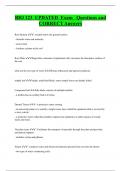
-
BIO 123 UPDATED Exam Questions and CORRECT Answers
- Exam (elaborations) • 12 pages • 2024
-
- $7.99
- + learn more
Root System - usually below the ground surface - Absorbs water and minerals - stores food - Anchors a plants in the soil Root Hairs finger-like extension of epidermal cells, increases the absorptive surface of the root what are the two type of roots fibrous (Monocot) and taproot (eudicots) simple leaf single, undivided blade. some simple leaves are deeply lobed. Compound leaf the blade consists of multiple leaflets. - a leaflets has no axillary bud at it's base Dermal Tissue - A ...
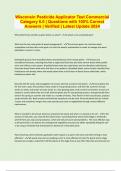
-
Wisconsin Pesticide Applicator Test Commercial Category 6.0 | Questions with 100% Correct Answers | Verified | Latest Update 2024
- Exam (elaborations) • 22 pages • 2024
-
- $12.49
- + learn more
What determines whether a given plant is a weed? - A weed is any unwanted plant What are the two main goals of weed management? - The primary goal is to minimize weed competition and the other main goal is to limit the weed's reproduction in order to manage the weed population in years to come. Distinguish grasses from broadleaf plants and herbaceous from woody plants - Grasses are considered monocots, meaning they have a single seed leaf, they also have narrow leaves with parallel veins ...

-
Bio 112 Exam 3 Janes TAMU Latest Update Graded A+
- Exam (elaborations) • 15 pages • 2024
- Available in package deal
-
- $9.99
- + learn more
Bio 112 Exam 3 Janes TAMU Latest Update Graded A+ Bryophytes Characteristics Vascular: no Seed Bearing: no Dominant Generation: gametophyte Examples/Phyla: liverwort, mosses, hornwort Special features: use spores, no seeds, need water for reproduction Paleozoic or Mesozoic: Paleozoic Ferns Characteristics Vascular: yes Seed Bearing: no Dominant Generation: sporophyte Examples/Phyla: monilophyta Special features: have sporangium Paleozoic or Mesozoic: Paleozoic Gymnosperms C...
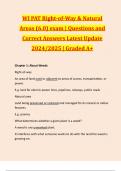
-
WI PAT Right-of-Way & Natural Areas (6.0) exam | Questions and Correct Answers Latest Update 2024/2025 | Graded A+
- Exam (elaborations) • 57 pages • 2024
- Available in package deal
-
- $12.99
- + learn more
WI PAT Right-of-Way & Natural Areas (6.0) exam | Questions and Correct Answers Latest Update 2024/2025 | Graded A+ Chapter 1: About Weeds Right-of-way An area of land used or adjacent to areas of access, transportation, or power. E.g. land for electric power lines, pipelines, railways, public roads Natural area Land being preserved or restored and managed for its natural or native features. E.g. prairies What determines whether a given plant is a weed? A weed is any unwanted plant....

-
Test Bank Oral Pathology for the Dental Hygienist 7th Edition Ibsen
- Exam (elaborations) • 210 pages • 2024
-
- $15.49
- 1x sold
- + learn more
Test Bank Oral Pathology for the Dental Hygienist 7th Edition IbsenContents Chapter 01: Introduction to Preliminary Diagnosis of Oral Lesions ......................................................... 1 Chapter 02: Inflammation and Repair .................................................................................................. 19 Chapter 03: Immunity and Immunologic Oral Lesions ......................................................................... 39 Chapter 04: Infectious Diseases ...

-
WI PAT Right-of-Way & Natural Areas (6.0) Exam 100% Solved correctly
- Exam (elaborations) • 41 pages • 2023
-
- $12.49
- + learn more
WI PAT Right-of-Way & Natural Areas (6.0) Exam 100% Solved correctly Define the terms "right-of-way" and "natural area". - ANS-*right-of-way*: an area of land used (or adjacent to) areas of access, transportation or power. Could include land used for electric power lines, pipelines, rialways, public roads, etc. -*natural areas*: land being preserved or restored and managed for its natural or native features Explain what determines whether a given plant is a weed. - ANS-considered a w...
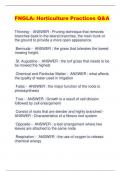
-
FNGLA: Horticulture Practices Q&A
- Exam (elaborations) • 8 pages • 2024
-
- $9.99
- + learn more
FNGLA: Horticulture Practices Q&A Thinning - ANSWER : Pruning technique that removes branches back to the lateral branches, the main trunk or the ground to provide a more open appearance. Bermuda - ANSWER : the grass that tolerates the lowest mowing height. St. Augustine - ANSWER : the turf grass that needs to be be mowed the highest Chemical and Particular Matter - ANSWER : what affects the quality of water used in irrigation False - ANSWER : the major function of the roots is ...

-
BOT3015 Quiz 2 Review (UCF) 2024 Exam Answers 100% Correct
- Exam (elaborations) • 9 pages • 2024
-
- $12.49
- + learn more
BOT3015 Quiz 2 Review (UCF) 2024 Exam Answers 100% Correct What do roots do? - Answer- - Anchor plants into soil - Absorption of water and minerals - Store food or water - Other specialized functions What happens to an embryo's radicle upon germination? - Answer- Radicle grows out and develops into first root. Radicle may develop into thick taproot with thinner branch roots. OR, after radicle formation, adventitious roots may arise that develop into a fibrous root system What are adv...

How much did you already spend on Stuvia? Imagine there are plenty more of you out there paying for study notes, but this time YOU are the seller. Ka-ching! Discover all about earning on Stuvia


